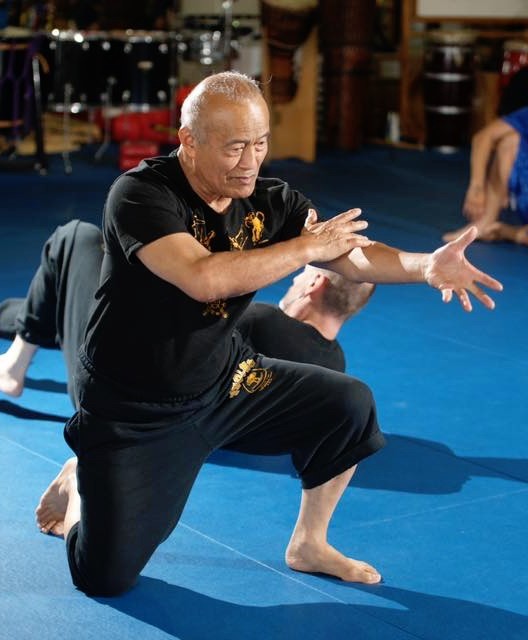AMAC Maphilindo Silat (Personal Training)
Personal training sessions can be done one on one with your coach, or you can bring a friend or family member to train with while the coach guides your training. These one-on-one sessions focus more on you and your goals and can be organized explicitly around what you want to accomplish. Private training also allows you to go at your own pace and advance when you feel ready. We have multiple instructors at the Academy, so you can choose who you prefer to work with. There are also numerous fitness-focused options that you can do in your private training to focus more on your health goals while you learn to defend yourself & your family.
Maphilindo Silat was founded by Guro Dan Inosanto, and is based on the various systems of Silat he has studied under Silat masters from Malaysia, the Philippines and Indonesia. Maphilindo Silat combines these Silat styles, using empty hand strikes, off‐balancing, kicks, punches, elbows, knees and nerve strikes.
Maphilindo Silat Personal Training Program

Maphilindo Silat was founded by Guro Dan Inosanto, and is based on the various systems of Silat he has studied under Silat masters from Malaysia, the Philippines and Indonesia. Maphilindo Silat combines these Silat styles, using empty hand strikes, off‐balancing, kicks, punches, elbows, knees and nerve strikes.
On top of being a great workout Silat is fantastic for loosening and opening the joints of the body. Silat is also a great addition for cross training with the Filipino Kali programs at the academy. Its powerful strikes with elbows and knees make it a formidable method of self defense. It also offers a very unique form of anti grappling (ground fighting) due to its powerful kicks from the ground position.
In the 5th and 6th centuries in Indonesia, an empire was formed due to the migration of the Buddhist tribes of India to Sumatra and Java. The Malay Srivijaya Empire, as it came to be known, eventually spread as far as the Philippines. Their martial arts skills, advanced weaponry and superior organization made it possible for them to conquer the earlier settlers. Some fled to distant islands, others stayed and the two cultures merged, creating varieties of Malayo‐Polynesian cultures and languages (ancestors of the Tahitian and Hawaiian ones).
The Srivijayas brought the influence of Buddhism and Hinduism philosophies, arts, and combative forms to the Philippines. They introduced laws (the famous Code of Kalantaw), a calendar, written alphabet (Sanskrit, on which the future Alibata alphabet will later be developed), new religion, and a system of weights and measures. This new culture developed a social unit called the barangay.
The next major incursion of foreign ideas and culture occurred in the late 13th century. The Majapahit Empire of Java, which eclipsed the Srivijaya Empire, spread throughout Southeast Asia and into the Philippines. Those were the golden days of the Malay culture.
At its height, the Majapahit Empire included areas that are today Indonesia, Malaysia, Thailand, Cambodia, Brunei and the Philippines. Deeply influenced by a Hindu‐Buddhist culture, the Majapahits brought their styles of Pencak Silat to the Philippines where they settled most heavily in the South (Mindanao and Sulu). This was when the Bugis warriors of Sulawesi had introduced the Keris sword (Kris) to the Philippines. It is thought by many Filipinos that the islands of Mindanao and Sulu were the birthplaces of Kali (the “mother art” of Filipino Martial Arts) during the Majapahit Empire.
From the Majapahit Empire and its connected kingdoms, a very specific Southern‐Asian martial art culture was born.
What we informally refer today as “Majapahit Martial Arts” include :
Filipino Martial Arts (Kali, Arnis, Eskrima, Silat Kuntao, etc.)
- Indonesian Pencak Silat
- Malaysian Seni Silat
- Tomoi (traditional Malaysian boxing)
- Muay Boran (traditional Thai boxing)
- Krabi Krabong (Thai weapons system)
- Myanma yuya louvi (traditional Myanmar boxing)
- Bokador (traditional Cambodian boxing)
- Long before the Spanish invasion, the Filipinos had developed their own systems of medicine (Hilot), astronomy, engineering, as well as written language and history. Most of these writings were destroyed during the Spanish conquest. Written and oral languages differed according to region so that today there are over 300 major dialects in addition to Tagalog, the national language.

Lessons are taught in a personal training format with an individual or a small group. There are countless benefits to training with a personal trainer. People of any age and experience level can see better results and live a healthier lifestyle. A personal trainer will help create a unique workout plan to fit your individual needs and goals, and can accommodate an injury or other obstacle that might otherwise prevent you from training or exercising.
